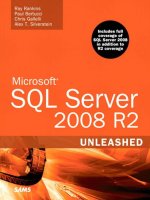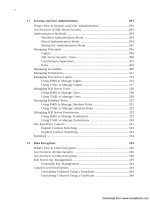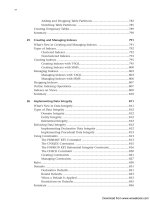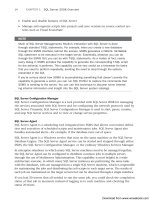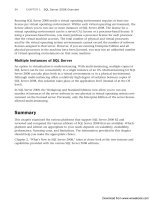Microsoft SQL Server 2008 R2 Unleashed- P132 pdf
Bạn đang xem bản rút gọn của tài liệu. Xem và tải ngay bản đầy đủ của tài liệu tại đây (220.14 KB, 10 trang )
ptg
1254
CHAPTER 35 Understanding Query Optimization
Query Plan Caching
SQL Server 2008 has a pool of memory used to store both execution plans and data. The
amount of memory allocated to execution plans or data changes dynamically, depending
on the needs of the system. The portion of memory used to store execution plans is often
referred to as the plan cache.
The first time a cacheable query is submitted to SQL Server, the query plan is compiled
and put into the plan cache. Query plans are read-only re-entrant structures shared by
multiple users. At most, there are two instances of a query plan at any time in the plan
cache: a serial execution plan and parallel query execution plan. The same parallel execu-
tion plan is used for all parallel executions, regardless of the degree of parallelism.
When you execute subsequent SQL statements, the Database Engine first checks to see
whether an existing execution plan for the same SQL statement already resides in the plan
cache. If it finds one, SQL Server attempts to reuse the matching execution plan, thereby
saving the overhead of having to recompile an execution plan for each ad hoc SQL state-
ment issued. If no matching execution plan is found, SQL Server is forced to generate a
new execution plan for the query.
The ability to reuse query plans for ad hoc queries in addition to caching query plans for
stored procedures can help improve the performance for complex queries that are
executed frequently because SQL Server can avoid having to compile a query plan every
time it’s executed if a matching query plan is found in memory first.
Query Plan Reuse
Query plan reuse for stored procedures is pretty straightforward. The whole idea behind
stored procedures is to promote plan reuse. For stored procedures and triggers, plan reuse
is simply based on the procedure or trigger name. The first time a stored procedure is
executed, the query plan is generated based on the initial parameters. On subsequent
executions, SQL Server checks the plan cache to see whether a query plan exists for a
procedure with the same name, and if one is found, it simply substitutes the new parame-
ter values into the existing query plan for execution.
Another method that promotes query plan reuse is using the sp_executesql stored proce-
dure for executing dynamic SQL statements. When using sp_executesql, typically you
specify a dynamic query with explicitly identified parameters for SARGs. Here’s an example:
sp_executesql N’select t.title, pubdate from bigpubs2008.dbo.authors a
join bigpubs2008.dbo.titleauthor ta on a.au_id = ta.au_id
join bigpubs2008.dbo.titles t on ta.title_id = t.title_id
where a.au_lname = @name’, N’@name varchar(30)’, ‘Smith’
When the same query is executed again via sp_executesql, SQL Server reuses the exist-
ing query plan (if it is still in the plan cache) and simply substitutes the different para-
meter values.
Download from www.wowebook.com
ptg
1255
Query Plan Caching
35
Although SQL Server can also match query plans for ad hoc SQL statements, there are
some limitations as to when a plan can be reused. For SQL Server to match SQL state-
ments to existing execution plans in the plan cache for ad hoc queries, all object refer-
ences in the query must be qualified with at least the schema name, and fully qualified
object names (database plus schema name) provide increased likelihood of plan reuse. In
addition, plan caching for ad hoc queries requires an exact text match between the
queries. The text match is both case sensitive and space sensitive. For example, the follow-
ing two queries are logically identical, but because they are not textually identical, they
would not share the same query plan:
select a.au_lname, t.title, pubdate
from authors a
join titleauthor ta on a.au_id = ta.au_id
join titles t on ta.title_id = t.title_id
select a.au_lname,
t.title,
pubdate
from authors a
join titleauthor ta on a.au_id = ta.au_id
join titles t on ta.title_id = t.title_id
Another factor that can prevent query plan reuse by matching queries is differences in
certain SET options, database options, or configuration options in effect for the user
session when the query is invoked. For example, a query might optimize differently for
one session if the ANSI_NULLS option is turned on than it would if it were turned off. The
following list of SET options must match for a query plan to be reused by a session:
. ANSI_PADDING
. FORCEPLAN
. CONCAT_NULL_YIELDS_NULL
. ANSI_WARNINGS
. ANSI_NULLS
. QUOTED_IDENTIFIER
. ANSI_NULL_DFLT_ON
. ANSI_NULL_DFLT_OFF
If any one of these setting values does not match the setting options for a cached plan,
the session generates a new query plan. Likewise, if the session is using a different
language or DATEFORMAT setting than that used by a cached plan, it needs to generate a
new execution plan. As you can see, sometimes fairly subtle differences can prevent plan
reuse.
Download from www.wowebook.com
ptg
1256
CHAPTER 35 Understanding Query Optimization
Simple Query Parameterization
For certain simple queries executed without parameters, SQL Server 2008 automatically
replaces constant literal values with parameters and compiles the query plan. This simple
parameterization of the query plan increases the possibility of query plan matching for
subsequent queries. If a subsequent query differs in only the values of the constants, it
matches with the parameterized query plan and reuses the query plan.
Consider this query:
SELECT * FROM AdventureWorks.Production.Product WHERE ProductSubcategoryID = 1
The search value 1 at the end of the statement can be treated like a parameter. When the
query plan is generated for this query, the Query Optimizer replaces the search value with
a placeholder parameter, such as @p1. This process is called simple parameterization. Using
the method of simple parameterization, SQL Server 2008 recognizes that following state-
ment is identical to the first except for the search value of 9 and would generate essentially
the same execution plan:
SELECT * FROM AdventureWorks.Production.Product WHERE ProductSubcategoryID = 9
This query will reuse the query plan generated by the first query.
NOTE
You can determine whether simple parameterization has been used for a quer y by
examining the query plan information for the query. If the query plan information con-
tains such placeholders as @p1 and @p2 in the search predicates when literal values
were specified in the actual query, you know simple parameterization has been applied
for the query. You can see an example of this in Figure 35.13 where parameters were
substituted in the query plan for the search arguments against qty and ord_date.
Query Plan Aging
A query plan is saved in cache along with a cost factor that reflects the cost of actually
creating the plan when compiling the query. For ad hoc query plans, SQL Server sets its
cost to 0, which indicates that the plan can be removed from the plan cache immediately
if space is needed for other plans. For other query plans, such as for a stored procedure,
the query plan cost is a measure of the amount of resources required to produce it. This
cost is calculated in “number of ticks.” The maximum plan cost is 31. The plan cost is
determined as follows:
Every 2 I/Os required by the plan = 1 tick (with a maximum of 19 ticks)
Every 2 context switches in the plan = 1 tick (with a maximum of 8 ticks)
Every 16 pages (128KB) of memory required for the plan = 1 tick (with a maximum of 4
ticks)
Download from www.wowebook.com
ptg
1257
Query Plan Caching
35
All reusable query plans remain in cache until space is needed in the plan cache for a new
plan. When space is needed, SQL Server removes the oldest unused execution plan from
the plan cache that has the lowest plan cost.
As plans age in cache, the plan cost is not decremented until the size of the plan cache
reaches 50% of the buffer pool size. When this occurs, the next access of the plan cache
results in the plan cost for all query plans being decremented by 1. As plans reside in the
plan cache over a period of time and are not reused, they eventually reach a plan cache
cost of 0 and thus become eligible to be removed from cache the next time plan cache
space is needed. However, when a query plan is reused, its plan cost is reset back to its
initial value. This helps ensure that frequently accessed query plans remain in the plan
cache.
Recompiling Query Plans
Certain changes in a database over time can cause existing execution plans to become
either inefficient or invalid, based on the new state of the database. SQL Server detects the
changes that invalidate an execution plan and marks the plan as not valid. A new plan is
then automatically recompiled the next time the query that uses that query plan is
invoked. Most query plan recompilations are required either for statement correctness or
to obtain potentially faster query execution plans. The types of conditions that can invali-
date a query plan include the following:
. Modifications made to the definition of a table or view referenced by the query
using ALTER TABLE and ALTER VIEW
. Changes made to any indexes used by the execution plan
. Updates to the statistics used by the execution plan via either the UPDATE STATIS-
TICS command or automatically
. Dropping of an index or indexed view used by the execution plan
. Execution of sp_recompile on a table referenced by the query plan
. Large numbers of changes to keys (generated by INSERT or DELETE statements from
other users that modify a table referenced by the query)
. Adding or dropping a trigger on a table
. When the number of rows in the inserted or deleted tables grows significantly
within a trigger defined on a table referenced in the query plan
. Execution of a stored procedure with the WITH RECOMPILE option specified
To avoid the unnecessary recompilation of statements that do not require it, SQL Server
2008 performs statement-level recompilation: only the statement inside the batch or
stored procedure that requires recompilation is recompiled. Statement-level recompilation
Download from www.wowebook.com
ptg
1258
CHAPTER 35 Understanding Query Optimization
helps improve query performance because, in most cases, only a small number of state-
ments within a batch or stored procedure cause recompilations and their associated penal-
ties, in terms of CPU time and locks. These penalties are therefore avoided for the other
statements in the batch that do not have to be recompiled.
Forcing Query Plan Recompiles
If you suspect that a query plan that is being reused is not appropriate for the current
execution of a query, you can also manually force the query plan to be recompiled for the
query. This capability can be especially useful for parameterized queries. Query parameteri-
zation provides a performance benefit by minimizing compilation overhead, but a para-
meterized query often provides less specific costing information to the Query Optimizer
and can result in the creation of a more general plan, which can be less efficient than a
more specific plan created for a specific set of literal values.
If the initial parameterized query plan generated for the query was not based on a repre-
sentative set of parameters, or if you are invoking an instance of the query with a nonrep-
resentative set of search values, you might find it necessary to force the Query Optimizer
to generate a new query plan. You can force query recompilation for a specific execution
of a query by specifying the
RECOMPILE query hint. For more information on specifying
the RECOMPILE query hint, see the “Managing the Optimizer” section, later in this chapter.
Monitoring the Plan Cache
You can view and get information about the query plans currently in plan cache memory
by using some of the DMVs available in SQL Server 2008. Following are some of the useful
ones related to monitoring the plan cache:
. sys.dm_exec_cached_plans—Returns general information about the query
execution plans currently in the plan cache.
. sys.dm_exec_query_stats—Returns aggregate performance statistics for cached
query plans.
. sys.dm_exec_sql_text—Returns the text of the SQL statement for a specified
plan handle.
. sys.dm_exec_cached_plan_dependent_objects—Returns one row for every
dependent object of a compiled plan.
. sys.dm_exec_plan_attributes—Returns one row per attribute associated with
the plan for a specified plan handle.
sys.dm_exec_cached_plans
The sys.dm_exec_cached_plans DMV provides information on all the execution plans
currently in the plan cache. Because the cache can have a large number of plans, you
usually want to limit the results returned from sys.dm_exec_cached_plans by using a filter
on the cacheobjtype column and also using the TOP clause. For example, the query shown
in Listing 35.1 returns the top 10 compiled plans currently in the plan cache, sorted in
descending order by the number of times the plan has been reused (usecounts).
Download from www.wowebook.com
ptg
1259
Query Plan Caching
35
LISTING 35.1 Returning the Top 10 Compiled Plans, by Usage Count
select top 10 objtype, usecounts, size_in_bytes, plan_handle
from sys.dm_exec_cached_plans
where cacheobjtype = ‘Compiled Plan’
order by usecounts desc
go
objtype usecounts size_in_bytes plan_handle
Prepared 127 65536 0x06000100962E9C11B820A207000000000000000000000000
Adhoc 110 49152 0x06000100804AD300B8E02D0C000000000000000000000000
Adhoc 40 16384 0x060001006CC40F18B860D80A000000000000000000000000
Adhoc 26 8192 0x0600040023900901B820A106000000000000000000000000
Adhoc 26 8192 0x060004003E77102CB8E0A306000000000000000000000000
Proc 17 8192 0x05000400F578A275B8405F07000000000000000000000000
Adhoc 17 8192 0x06000400EBC44D2AB880A006000000000000000000000000
Adhoc 15 8192 0x060001001AF2320BB8801A08000000000000000000000000
Proc 12 212992 0x05000400744F1F67B8604F0E000000000000000000000000
Proc 12 49152 0x050004006A934A11B8C0550E000000000000000000000000
The types of plans in the plan cache are listed under the cacheobjtype column and can be
any of the following:
. Compiled Plan—The actual compiled plan generated that can be shared by
sessions running the same procedure or query.
. Compiled Plan Stub—A small, compiled plan stub generated when a batch is
compiled for the first time and the Optimize for Ad Hoc Workloads option is
enabled. It helps to relieve memory pressure by not allowing the plan cache to
become filled with compiled plans that are not reused.
. Executable Plan—The actual execution plan and the environment settings for
the session that ran the compiled plan. Caching the environment settings for an
execution plan makes subsequent executions more efficient. Each concurrent execu-
tion of the same compiled plan will have its own executable plan. All executable
plans are associated with a compiled plan having the same plan_handle, but not all
compiled plans have an associated executable plan.
. Parse Tree—The internal parsed form of a query generated before compilation
and optimization.
. CLR Compiled Func—Execution plan for a CLR-based function.
. CLR Compiled Proc—Execution plan for a CLR-based procedure.
. Extended proc—The cached information for an extended stored procedure.
Download from www.wowebook.com
ptg
1260
CHAPTER 35 Understanding Query Optimization
The type of object or query for which a plan is cached is stored in the objtype column.
This column can contain one of the following values:
. Proc—The cached plan is for a stored procedure or inline function.
. Prepared—The cached plan is for queries submitted using sp_executesql or for
queries using the prepare and execute method.
. Adhoc—The cached plan is for queries that don’t fall into any other category.
. ReplProc—The cached plan is for replication agents.
. Trigger—The cached plan is for a trigger.
. View—The cached plan is for a view or a noninline function. You typically see a
parse tree only for a view or noninline function, not a compiled plan. The view or
function typically does not have its own separate plan because it is expanded as part
of another query.
. UsrTab or SysTab—The cached plan is for a user or system table that has computed
columns. This is typically associated with a parse tree.
. Default, Check, or Rule—The cached plan is simply a parse tree for these types of
objects because they are expanded as part of another query in which they are
applied.
To determine how often a plan is being reused, you can examine the value in the
usecounts columns. The usecounts value is incremented each time the cached plan is
looked up and reused.
sys.dm_exec_sql_text
Overall, the information returned by sys.dm_exec_cached_plans is not overly useful
unless you know what queries or stored procedures these plans refer to. You can view the
SQL text of these query plans by writing a query that joins sys.dm_exec_cached_plans
with the sys.dm_exec_sql_text DMV. For example, you can use the query shown in
Listing 35.2 to return the SQL text for the top 10 largest ad hoc query plans currently in
the plan cache.
LISTING 35.2 Returning the Top 10 Largest Ad Hoc Query Plans
select top 10 objtype, usecounts, size_in_bytes, plan_handle,
the following removes newline and carriage return from the sql text
replace(replace( text, char(13), ‘ ‘), char(10), ‘ ‘) as sqltext
from sys.dm_exec_cached_plans as p
cross apply sys.dm_exec_sql_text (p.plan_handle)
where cacheobjtype = ‘Compiled Plan’
and objtype = ‘Adhoc’
order by size_in_bytes desc, usecounts desc
Download from www.wowebook.com
ptg
1261
Query Plan Caching
35
sys.dm_exec_query_stats
The plan cache also keeps track of useful statistics about each cached plan, such as the
amount of CPU or the number of reads and writes performed by the query plan since it
was placed into the plan cache. This information can be examined using the
sys.dm_exec_query_stats DMV, which returns statistics for each statement in a stored
procedure or a SQL batch. To provide statistics for the procedure or batch as a whole, you
need to summarize the data. Listing 35.3 provides a sample query that returns the I/O,
CPU, and elapsed time statistics for the 10 most recently executed stored procedures.
LISTING 35.3 Returning Query Plan Stats for the 10 Most Recently Executed Procedures
select TOP 10 usecounts, size_in_bytes,
max(last_execution_time) as last_execution_time,
sum(total_logical_reads) as total_logical_reads,
sum(total_physical_reads) as total_physical_reads,
sum(total_worker_time/1000) as total_CPU_time,
sum(total_elapsed_time/1000) as total_elapsed_time,
replace(substring (text,
patindex(‘%create procedure%’, text),
datalength(text)),
‘create procedure’, ‘’) as procname
from sys.dm_exec_query_stats s
join sys.dm_exec_cached_plans p on s.plan_handle = p.plan_handle
CROSS APPLY sys.dm_exec_sql_text(p.plan_handle) as st
where p.objtype = ‘Proc’ and p.cacheobjtype = ‘Compiled Plan’
group by usecounts, size_in_bytes, text
order by max(last_execution_time) desc
Table 35.1 describes some of the most useful columns returned by the
sys.dm_exec_query_stats DMV.
TABLE 35.1 Description of Columns for sys.dm_exec_query_stats
Column Name Description
statement_start_offset
The starting position of the query that the row describes within the
text of its batch or stored procedure, indicated in bytes, beginning
with 0.
statement_end_offset
The ending position of the query that the row describes within the
text of its batch or stored proc. A value of -1 indicates the end of
the batch.
plan_generation_num
The number of times the plan has been recompiled while it has
remained in the cache.
Download from www.wowebook.com
ptg
1262
CHAPTER 35 Understanding Query Optimization
TABLE 35.1 Description of Columns for sys.dm_exec_query_stats
Column Name Description
plan_handle
A pointer to the plan. This value can be passed to the
dm_exec_query_plan dynamic management function.
creation_time
The time the plan was compiled.
last_execution_time
The last time the plan was executed.
execution_count
The number of times the plan has been executed since it was last
compiled.
total_worker_time
The total amount of CPU time, in microseconds, consumed by
executions of this plan for the statement.
last_worker_time
The CPU time, in microseconds, consumed the last time the plan
was executed.
min_worker_time
The minimum CPU time, in microseconds, this plan has ever
consumed during a single execution.
max_worker_time
The maximum CPU time, in microseconds, this plan has ever
consumed during a single execution.
total_physical_reads
The total number of physical reads performed by executions of this
plan since it was compiled.
last_physical_reads
The number of physical reads performed the last time the plan was
executed.
min_physical_reads
The minimum number of physical reads this plan has ever
performed during a single execution.
max_physical_reads
The maximum number of physical reads this plan has ever
performed during a single execution.
total_logical_writes
The total number of logical writes performed by executions of this
plan since it was compiled.
last_logical_writes
The number of logical writes performed the last time the plan was
executed.
min_logical_writes
The minimum number of logical writes this plan has ever performed
during a single execution.
max_logical_writes
The maximum number of logical writes this plan has ever performed
during a single execution.
total_logical_reads
The total number of logical reads performed by executions of this
plan since it was compiled.
last_logical_reads
The number of logical reads performed the last time the plan was
executed.
Download from www.wowebook.com
ptg
1263
Query Plan Caching
35
The query_hash and query_plan_hash values are new for SQL Server 2008. You can use
these values to determine the aggregate resource usage for queries that differ only by
literal values or with similar execution plans. You can use these values to write queries
that you can use to help determine the aggregate resource usage for similar queries and
similar query execution plans. For example, Listing 35.4 provides a query to find the
query_hash and query_plan_hash values for queries that select from the titles table
searching by ytd_sales. Looking at the results, you can see that even with different search
arguments, each of the matching queries generates the same query hash value, but they
have different query plan hash values for queries that use different query plans.
LISTING 35.4 Returning Query and Query Plan Hash Values for a Query
SELECT convert(varchar(41), substring(st.text, 1, 42)) AS ‘Query Text’,
qs.query_hash AS ‘Query Hash’,
qs.query_plan_hash as ‘Query Plan Hash’
FROM sys.dm_exec_query_stats qs
CROSS APPLY sys.dm_exec_sql_text (qs.sql_handle) st
WHERE st.text like ‘SELECT * from titles where ytd_sales%’
go
TABLE 35.1 Description of Columns for sys.dm_exec_query_stats
Column Name Description
min_logical_reads
The minimum number of logical reads this plan has ever performed
during a single execution.
max_logical_reads
The maximum number of logical reads this plan has ever performed
during a single execution.
total_elapsed_time
The total elapsed time, in microseconds, for completed executions
of this plan.
last_elapsed_time
The elapsed time, in microseconds, for the most recently completed
execution of this plan.
min_elapsed_time
The minimum elapsed time, in microseconds, for any completed
execution of this plan.
max_elapsed_time
The maximum elapsed time, in microseconds, for any completed
execution of this plan.
query_hash
The binary hash value calculated on the query and used to identify
queries with similar logic.
query_plan_hash
The binary hash value calculated on the query execution plan and
used to identify similar query execution plans.
Download from www.wowebook.com
